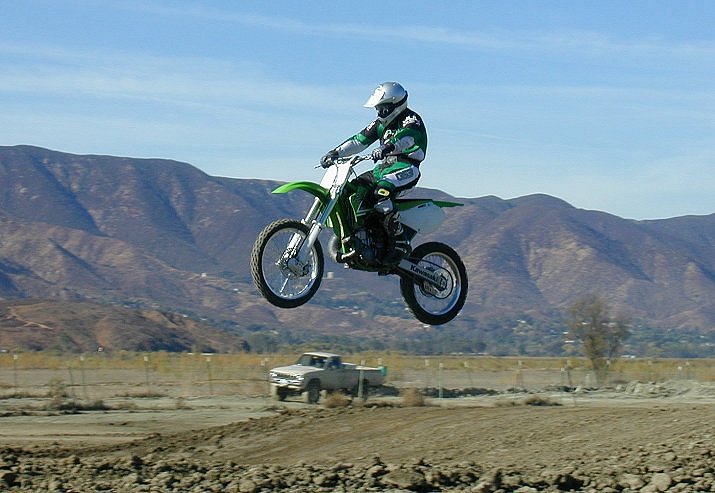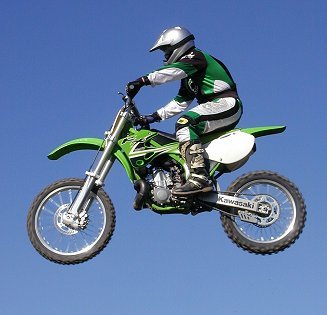
In 1990, Kawasaki became the first manufacturer of a mass-produced perimeter frame motocrosser. Both the KX250 and the KX125 debuted that year with trick, perimeter-style steel frames. No other major manufacturer has followed Kawasaki’s lead — Honda adopted a perimeter-style aluminum frame in the late 1990s.
Since 1990, Kawasaki has won plenty of championships with this frame design. Indeed, Kawasaki is the only manufacturer to beat Jeremy McGrath (who won on both Hondas and Yamahas) to the 250 Supercross crown in the last decade (with Jeff Emig and Ricky Carmichael). Meanwhile, Mike Kiedrowski, Jeff Emig and Ricky Carmichael all achieved 250 Outdoor National Motocross championships (and Carmichael has a handful of 125 Outdoor National championships, as well) while mounted on perimeter-framed Kawasakis. The design flat works — particularly, outdoors, where speeds are higher and tracks are rougher.
Kawasaki has carefully refined this perimeter frame design over the years, most recently in 1999. The current machine which is the subject of our ride review, the 2002 KX250, continues with the 1999 frame design but adds some new features to improve performance over last year. Most notably, Kawasaki is the first Japanese manufacturer to feature 48 mm fork tubes on its stock machine. This is the fork diameter favored by factory riders. KTM is the only other major dirt bike manufacturer to offer 48 mm fork tubes stock (on its SX models, only).
Other changes/refinements for 2002 include new front brake pistons (now aluminum), re-valved rear suspension, new stainless steel footpegs, new handlebar, and a host of engine and transmission changes. The engine and transmission changes include a new, more powerful “twin spark” ignition system, new cylinder porting, new two-piece KIPS powervalve, and new, taller top three gear ratios.

Ricky Carmichael took a modified version of last year’s KX250 to thirteen straight supercross victories, the 250 Supercross championship and the Outdoor National championship. How does the stock 2002 KX250 measure up?
The engine performance of the 2002 KX250 is very smooth and very strong off the bottom. The bike pulls hard from the low end through the mid-range, but doesn’t rev out quite as well as some of the competition.
The low-to-mid powerband is not only strong, but electric-smooth. Combined with an effective rear shock, the KX hooks up extremely well exiting corners. This powerband also allows the KX250 to be throttle-steered extremely effectively and controllably.
The KX250 is renowned for its stability, and the 2002 model is no different. Indeed, the beefier front forks impart an extremely solid feel from the front end that compliments the already stiff feeling perimeter frame quite well. The KX250 tracks like a locomotive through rough straights.
Although the incredible straight-line stability does result in some trade-off in the corners, the KX250 still corners quite well. Kawasaki spent years refining the perimeter frame — gradually, trading off some of the straight-line stability for increased cornering quickness. The current frame strikes an excellent compromise. The KX250 tracks ruts very well, and, as stated earlier, will throttle-steer through flat turns with precision. It is not the quickest bike through bermed corners, but it isn’t bad there, either.
Like most stock bikes, the suspension action can be too soft for heavier or faster motocross riders, who will need to swap out the fork springs, in particular, for heavier weight springs. For novice motocross riders up to approximately 180 pounds and for virtually all trail/play riders, the stock suspension settings and spring rates should work just fine, however.
The 48 mm KYB forks used by Kawasaki do feel stiffer than the 46 mm KYBs used by some of the competition. These forks also handle big hits (including, particularly, flat jump landings) as well as any stock fork in memory. They are plush, but they do not bottom (even with a 200 pounder aboard). The forks also track well through corners and are reasonably plush on choppy straights. High speed compression damping might be a little bit stiff, and this is particularly noticeable through braking bumps (the hardest test for any fork) and acceleration bumps. Here, the forks do impart some harshness that is difficult to dial out with the stock valving.
The shock, meanwhile, is all good as far as we are concerned. Set your sag at 100 mm and go. The stock compression and rebound settings were never touched. The rear wheel tracks well exiting corners, is reasonably plush on choppy straights, and doesn’t kick through the whoops.

The new, straighter handlebar, combined with Kawasaki’s adjustable handlebar perches (which can be rotated forward to put the bar further from the rider — our preferred position) make for a roomier layout, and better cornering. Moving the bars and the controls further forward allows the rider to more comfortably weight the front end of the bike through turns and, by itself, means the Kawasaki turns just that much better this year. Additionally, Kawasaki raised the rear of the KX250 with longer pull rods in the shock linkage this year (a popular modification to past KXs pioneered by the Pro Circuit race teams). This also quickens steering and throws additional weight on to the front wheel.
The revised transmission shifts well, even under power. The wide ratios (higher third, fourth and fifth gears) don’t seem to hinder acceleration on the track (the shift from second to third gear puts you right back in the meat of the powerband), and makes the KX much more versatile as an off-road, play bike.
Kawasaki was guilty of “mushy” brakes — particularly, the front brake — for years. That was dramatically changed prior to this year, however, through the use of a revised master cylinder design. The improved brakes carry forward to the 2002 model, which also features aluminum pistons in the front brake caliper (reducing weight). The front brake provided good power and modulation, and was well balanced with the rear brake. The bottom line is that Kawasaki now has a very competitive front brake, which is important to riders of all skill levels. The only modification you might make is to re-route the front brake cable Honda-style (without looping under the caliper bracket). This will provide a slight improvement in both power and feel. Only Honda provides this routing stock.
The ergonomics of the KX250 feel somewhat different from other Japanese 250 motocrossers. The perimeter frame makes the bike a bit wider at the radiator shrouds, causing the rider to spread his legs a bit more while gripping the bike. This is either good or bad, depending on your perspective. Some riders will find the KX250 easier to grip, because many other bikes are “too thin”. Others will feel the KX is too broad and girthy.
The rest of the layout is quite comfortable. The relationship between the bar, seat and pegs, particularly with the new bars a bit further forward, allows riders to move freely on the bike. We didn’t have any problems with the body work catching our boots or clothing, either.
The new, thicker graphics provided by Kawasaki are the most durable stock graphics we have encountered. Rather than being slick, they have a slight texture to them, which also seems to help you grip the bike with your legs in the shroud area.
The bottom line is that we like the 2002 KX250 very much. The stock motor is super smooth and easy to ride. Kawasaki has dramatically reduced the vibration level, and the bike does not tire you out the way many other 250 two-strokes will. The rubber-mounted handlebars allow customization of the bar position, and an easy switch to oversized bars, as well.
While the stock motor is likely to lack the top end rush faster intermediates and pros would like, virtually ever rider in those categories will port their motor. The KX250 actually provides a bit of a head start to faster riders who want a stiffer front-end featuring 48 mm fork tubes.
In our opinion, the KX250 has received an unfair rap in some of the “shoot-outs”. Like KTM, Kawasaki has gone its own direction with frame design and ergonomics. Different is not automatically bad, but it can feel that way when jumping from bike to bike. Riders used to other Japanese brands may feel a bit uncomfortable when they first jump on the KX250. Given a chance, and some seat time, the KX250 is an extremely rewarding bike to ride, and you don’t have to be as fast as Ricky Carmichael or Jeff Emig to appreciate it.
The U.S. MSRP of the 2002 KX250 is $5,799. Check out Kawasaki’s site for details and specs.





